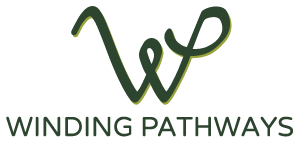by Winding Pathways | Apr 22, 2021 | (Sub)Urban Homesteading, Garden/Yard, Mammals
Readers’ Adventures With Pogo Possum
The Pogo Possum adventures really resonated with people. So, Winding Pathways is sharing some of these.
SA enthusiastically wrote: I love that you named him Pogo. “We have met the enemy and he is us.”
JH has a thoughtful perspective: Pogo certainly has some caring humans. I agree with you that they are very interesting critters. I just wish the rest of the world that zips by in four-wheeled contraptions would think likewise instead of hitting them.
MH shared: We found one in our house. I was gone for a week. I like fresh air at night so left an outside door open that had a small hole in the screen my husband called to say there was a pile of poop in the living room. On investigation, he found one hidden behind our TV console. We guessed he came in through the screen.
From Colleges to Communities Pogo Resonates
MM told about Kirkwood Community College’s adventures: While at Kirkwood, when the original greenhouses were attached to my Grounds Department building, we found a female, with babies, living in the north greenhouse. Once Stacey, the students, and my crew understood the benefits of having this tenant, we left her and her babies alone. Occasionally, one of the babies would explore the greenhouse, but with a little coaxing, he or she would return to the nest. I was fortunate to see the mother finally take her young out of the greenhouse, exposing them to their new life outside of the greenhouse environment. I don’t know if it was the same opossum or one of the babies, but one of them must have been paying rent, as each year we welcomed a resident, with babies. I do miss the interaction and YES, I was providing a bit of food, as well as the occasional rat or mouse courtesy of the raptor building behind our greenhouses.
SR What a lovely story about Pogo, your cozy little possum neighbor! Friends not far from you have another small one who scoots on into the garage for cat food whenever the door is open. One day she found it curled up for a daytime nap inside the watering can in her garage. What a handy handle to walk it on back outside. The sleepy little creature just looked up blinking its eyes and smacking its possum smile. Then it ambled right out of the watering can once she put it down on its side. I dare anyone to try this with a raccoon or even a groundhog.
AF Too cute to pass up commenting on. We too have a possum neighbor.
PL succinctly wrote: Love Pogo!!!
Thank you, all for sharing your Pogo adventures! This looks like a periodic series on an ancient, maligned and interesting resident among us.
-
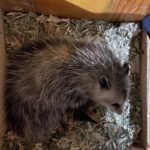
-
After eating an egg, Pogo took a nap.
-
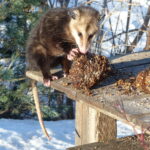
-
Possums have agile hands.
-
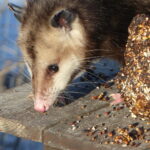
-
On a cold winter day Pogo appeared.
Thank you, all for sharing your Pogo adventures! This looks like a periodic series on an ancient, maligned, and interesting resident among us.
by Winding Pathways | Mar 4, 2021 | Garden/Yard, Mammals
Bright sun and warm breezes broke Iowa’s February subzero weather. Being outside unencumbered by thick gloves, boots, and coats felt great, and we even enjoyed a cup of coffee sitting outside on the sunny side of our home. We weren’t alone. A glance at the bird feeder one late afternoon revealed a friend we hadn’t seen in months. An opossum was enjoying a meal of seeds while basking in the relative warmth. We suspect the animal had spent frigid days and nights dormant under a brush pile.
Many people don’t like possums but we do. They’re fascinating – and helpful! The Iowa DNR lists these little-known facts about Iowa’s only marsupial, an animal that cares for its young in a pouch similar to the Australian kangaroo.
-
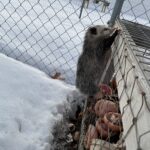
-
This young possum climbs up the compost bin to scavenge food.
-

-
In broad daylight this possum feasted on a block of seeds.
-

-
Possums have agile hands.
Fun Facts About Opossums
- Possums are virtually immune to rabies.
- A copperhead or rattlesnake might bite a possum and be surprised. These ancient animals are immune to their poison and will likely gobble up the hapless snake for lunch. Not so much in Iowa. Poisonous snakes are rare here and only found in a few areas.
- No other native mammal has as many teeth. Opossums have 50. When approached they’ll often open their mouth and show them off. They also might hiss, but our possums didn’t make any threatening moves.
- Possums play possum. It discourages some predators but doesn’t work with cars. Many are killed as they crossroads. Do avoid hitting them.
- Possums have hind feet that look a bit like a human hand. Their tracks in the snow are distinctive.
- Female opossums have 13 teats. Twelve are in a circle in her pouch with one in the center.
- Babies are tiny. The size of a dime. After birth, they finish developing in mom’s pouch. When they are older, they’ll often ride on her back.
- Some sources say opossums reduce tick numbers. They often groom themselves and consider any tick they find a tasty snack.
We enjoy seeing our opossum friends. On cold nights we sometimes put a little cat or dog food out for them. Life’s not easy for these animals with naked tails and thin fur, so we try to help them.
by Winding Pathways | Dec 3, 2020 | (Sub)Urban Homesteading, Garden/Yard, Mammals, Nature, Pests
What a year this has been! Coronavirus altered the lives of nearly everyone. Many of us now work from home and spend the day staring at a computer screen and attending zoom meetings.
A delight of working from home is entertainment right outside the window. Sometimes we take our eyes off the screen, glance outside, and grin as we watch chipmunk antics.
No Need To Feed
We don’t really feed our chipmunks. They’re opportunists. When chickadees, nuthatches and other birds drop seeds from hanging feeders the chippies are right there filling their cheeks with sunflower seeds and dashing off to store them in their underground burrows.
Manly people detest these small, beautiful mammals and cite the damage they do to retaining walls and lawns. Our retaining wall is crafted of huge glacial boulders. Its many nooks and crannies are perfect for chipmunks but are so sturdy chipmunks can’t damage it. They give us cheer in a perplexing year.
Many species of chipmunks live in the United States but the one most common in suburban areas between the Atlantic and the Great Plains is the Eastern Chipmunk. Almost everyone can identify this animal that only tips the scale at two to three ounces. Counting its tail, a big one might stretch a foot long.
Where Do Chipmunks Live?
Chipmunks love what biologists call “structure”. A pile of firewood or old lumber, a brush pile, a rarely used shed, or a retention wall is structure that makes a dandy home for chipmunks. They typically create an extensive subterranean home under structures that is an extensive tunnel system with several entrances to the surface.
What’s In a Name?
Chipmunks were named by the Ojibwe Tribe with the words that mean, “one who descends trees headfirst.” Climb they can! Chipmunks scamper up and down trees and bushes and easily reach our bird feeding platform. They prefer sunflower seeds and stuff their cheek pouches until they seem ready to burst. Then they scoot off to store seeds down in their tunnels. We wonder how big that pile of seeds might be! Chippies also eat wild seeds, acorns, and even an occasional insect.
During the coldest weather chippies stay underground and sleep in a kind of torpor. They don’t hibernate and probably enjoy snacking on the sunflower seeds they cashed months before. Last winter one tunneled under the snow and emerged under our bird feeder for fresh seeds.
Overall Delight
We love watching our chipmunks chase one another up, down and around the feeder and retaining wall. Suburban chipmunks are fortunate. Snakes and raptors love snacking on them but people keep long, skinny reptiles out of yards and not many hawks venture near homes. Since chipmunks are day shift animals our barred owls don’t get a crack at them because they work the night shift.
So, in exchange for a safe place to eat, a scoop of seeds daily, and a cozy retaining wall to burrow in, our chipmunks give us a humorous and interesting break from working at home chores. CBS recently aired a short on a food editor who, during Coronavirus time has catered to a chipmunk outside her home. Sweet and tender show!
-
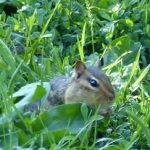
-
Foraging for seeds.
-
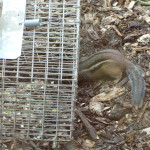
-
Having excavated, the chipmunk now enters the tunnel to get the corn.
-

-
The chipmunk figured how to tunnel under the live trap, gather up the corn and emerged with pouches full.
-
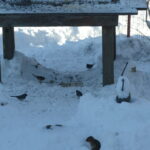
-
Chipmunks forage under the bird feeding platform.
by Winding Pathways | Oct 29, 2020 | Mammals, Nature, Reflections/Profiles
We settle into fall and sometimes like to just browse past stories. Here are some links to more recent Gazette features and natures notes.
Explore Iowa’s National Parks. August 2020
Take Advantage of Iowa’s County Gems July 2020
Why RV Life Isn’t for These Senior Tent Campers. July 2020
Bear Sightings in Iowa Getting More Common. June 2020
Take a Walk on the Wilder Side April 2020
Derecho Stories: Get Outside and Walk But Stay Safe September 2020, Rebirth Amid the Rubble September 2020
-

-
Overlook from Effigy Mounds
-
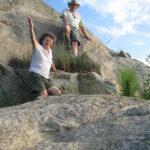
-
A near, fun place to walk and climb is Waldo’s rock.
-
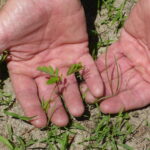
-
Prairie plant
-
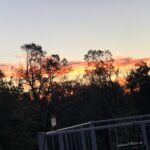
-
Sunrise on a changed landscape
-
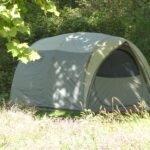
-
We have adjusted to getting older by using a larger tent and cots.
-
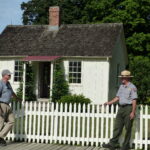
-
Herbert Hoover was Iowa’s only president.
-
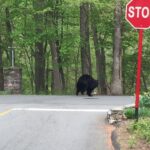
-
Bear sightings are more common in Iowa.
by Winding Pathways | Oct 22, 2020 | (Sub)Urban Homesteading, Mammals, Pests
Early one September morning a disturbing sight greeted us. The metal post holding a suet feeder high off the ground was bent. The feeder was gone. After a search we finally found it where our nocturnal thieves had abandoned it after devouring the suet.
Many people are frustrated when daytime squirrels gobble up feeder seed, but other mammals visit feeders unseen after sunset. Not all are as rough on feeders as raccoons and all night visitors are interesting but they can also be frustrating.
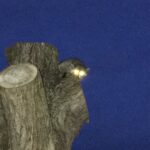
Raccoons are strong and hungry.
Up in the wee hours sleepless or just to get a snack? Shine a flashlight beam on the feeder. You may spot raccoons, deer, flying squirrels, or even a bear! They all like birdseed and some relish suet.
Raccoons live nearly everywhere, even in big cities. Our son once sent a picture he took of one raiding a dumpster in New York City. Occasionally they are out on cloudy days but mostly they are nocturnal.
Raccoons are common, numerous, powerful, and gregarious. Sometimes a whole family visits a feeder after dark. Excellent climbers, if they can’t shinny up a slippery metal pole to reach seed, they might just bend it over as they did at Winding Pathways. They love suet but also eat corn, sunflower seeds, and many other foods people put out for birds.
One of the most endearing animals to visit feeders are flying squirrels. There are two species but both are nocturnal and are almost never seen during daylight. Flying squirrels often live in big dead hollow trees and are more common than most people realize.
Flying squirrels are misnamed mammals. They can’t fly. They should be called gliding squirrels, for they spread loose skin on their sides and glide from the top of a tree to the ground – or bird feeder. These mammals weigh only about two ounces, about half that of an Eastern chipmunk. In comparison, a mature gray squirrel is ten times heavier at about 20 ounces.
Flying squirrels are shy and beautiful. Seeing one is a thrill.
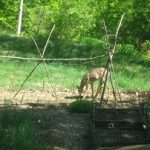
Deer In Garden Photo by S. Fehsinger
Like raccoons and flying squirrels, deer love birdseed. Sometimes they visit during the day but we see them more often after dark. If a feeder is well seed stocked in the evening but is empty come morning deer are likely culprits. Look for their tracks and droppings to confirm the visit.
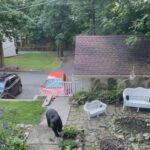
Bears make themselves at home anywhere.
Bears
Gads. Bears at the feeder! Could be. We don’t live in bear country but they are common over much of the United States. Mostly nocturnal, they love birdseed and suet. A 300-pound bear can rip down the most armored feeder and they’re skilled trash can scroungers as well.
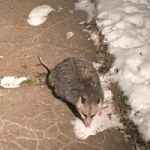
A ‘possum snuffling for food. Photo J. Jones
Skunks, Possums, and Rats
Skunks, opossums, and Norway Rats all love birdseed. Like flying squirrels and raccoons, they are nocturnal. Skunks and possums are native animals that can be comical, but no one wants rats around. They are dangerous pests capable of spreading disease and gnawing on houses.
REDUCING NOCTURNAL FEEDER VISITORS
There’s an effective way to discourage nocturnal feeding wildlife. It’s a two-step process:
- Only put out the amount of seed birds are likely to eat in a day. Empty feeders may attract nocturnal animals but pickings are slim and discouraging.
- Better yet bring all feeders inside by sunset. Store them overnight in a metal trash can with a tight-fitting lid to keep mice from being tempted to raid it even if it’s indoors.
Feeding birds is entertaining and educational. We love having colorful activity just outside our window. We’re not thrilled when raccoons tear up the feeders, so when midnight raiders help themselves, we bring feeders in each evening.
by Winding Pathways | Oct 1, 2020 | (Sub)Urban Homesteading, Birds, Mammals, Nature
We’ll remember August 10, 2020, forever. On that day the wind changed Eastern Iowa and Winding Pathways in a way that will persist for a century. In 40 minutes, straight-line wind gusts up to 140 miles an hour toppled or broke 47 of our 53 trees. Two landed on our roof.
Our property adjoins Faulkes Heritage Woods, a 110-acre preserve of tall old trees, mostly oaks. The derecho felled most of its big trees that tumbled into a jumbled mass of trunks, branches, and leaves.
-
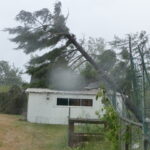
-
The pine toppled onto the cabin roof.
-
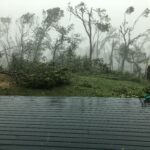
-
Effects of straight-line winds.
-
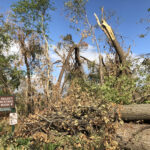
-
Twisted trees.
Wondering how the great change would impact wildlife, we quickly noticed two short term impacts. August and September are usually slow months for bird feeder visitors as birds normally have plenty of wild food. As soon as the wind calmed, all was still. Faithfully, Rich found and filled the feeders. The next morning, we noticed heavy use by house finches, titmice, nuthatches, cardinals, woodpeckers, and chickadees. It was almost like the feeding frenzy that happens as a winter blizzard approaches.
Short Term Impacts
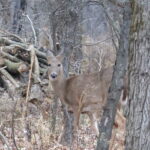
Trails are disrupted.
We quickly realized that deer, raccoons, coyotes, woodchucks, squirrels, and even chipmunks experienced a life-changing event. Their travel corridors changed as huge trees blocked deer trails, for example. They had to find new routes through the debris. One afternoon we saw a mother deer and fawn walking on the one remaining “open” trail around our prairie. Then, they crawled under a fallen tree and disappeared into the maze of branches. The ever clever raccoons have become more than pests as they tear up feeders and raid garbage cans. Also, the storm destroyed this year’s acorn and walnut crop, nuts that many species require. That is why the birds came so readily to the feeders. And still do!
-

-
The house finches eat serenely.
-

-
Even the crows come around to grab a snack.
-
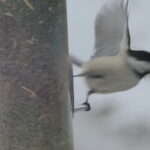
-
From early light to last dusk chickadees work the feeders.
Longer-Term Impacts
We are now watching for the long term impacts of the loss of so many trees. Our good friend, Jim Berry, is the former executive director of the Roger Tory Peterson Institute in New York. We asked him what we might expect following the loss of so many big trees in Faulkes Woods and our property.
“There are winners and losers. I would expect to see fewer wood thrushes, ovenbirds, and scarlet tanagers. They prefer mature forests. The more open woods and sunshine hitting the ground will cause an increase in cardinals, robins, and white-eyed vireos,” he said.
We have been fortunate to enjoy seven woodpecker species over the years. Some will benefit and some will lose from the great woods opening windstorm. According to Jim red-headed, red-bellied, and downy woodpeckers are likely to increase. So will flickers.
But sapsuckers and hairy and pileated woodpeckers that like the old trees and a closed canopy will probably decline.
-
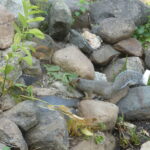
-
The small mammals are hungry.
-
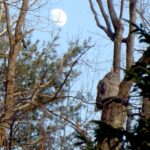
-
Owls will benefit from broken trees as cavities develop.
-
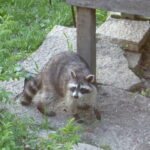
-
Raccoons ravage feeders at night.
The loss of hollow trees that shelter animals and the destroyed nut crop are going to make this a lean winter for squirrels. Deer, blue jays, woodchucks, chipmunks, and wild turkeys will also miss the acorns that normally rain down each fall.
We were saddened to lose so many trees but look forward to watching the forest restore itself. We’re also watching to see changes in wildlife.
